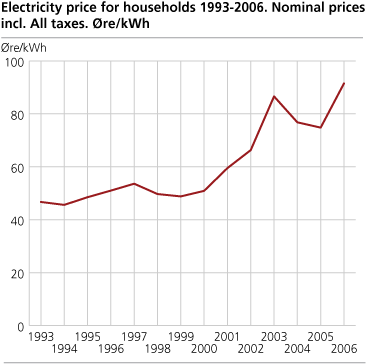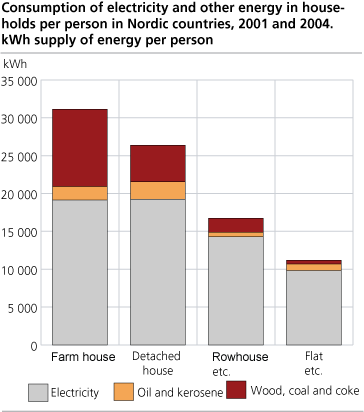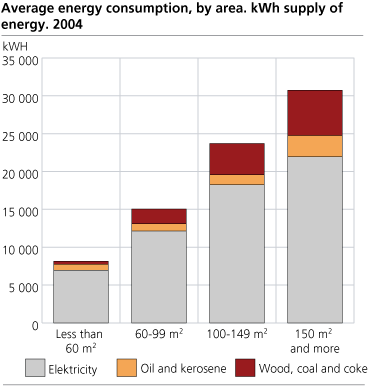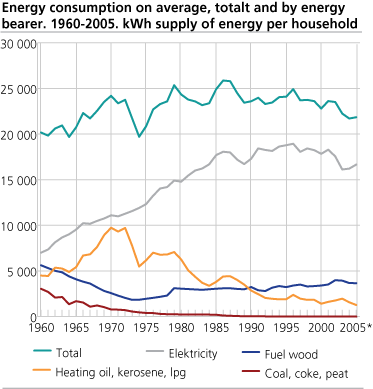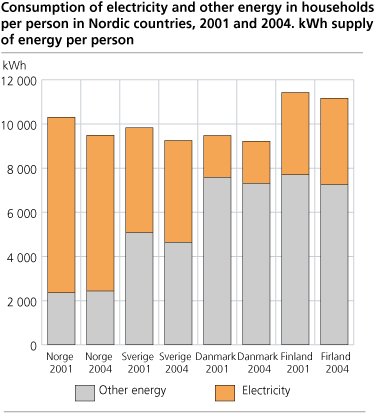Content
Published:
This is an archived release.
Reduced electricity consumption per household
The electricity consumption per household was significantly lower in 2004 than what has previously been considered normal for Norwegian households. This is partly due to higher electricity prices that have triggered energy-reducing efforts.
|
The survey is based on the Statistic Norway’s annual expenditure survey for households, with additional questions on energy included for 2004. Statistics Norway performs this kind of energy surveys from time to time, and the previous corresponding surveys were for 2001 and 1993-1995. The data material can be used as a basis for coupling data for energy consumption in households with information about house type, household size, dwelling area, heating equipment such as heat pumps, and other factors that influence energy consumption. The results for 2004 are based on answers from about 1100 households. |
Since 2001, the electricity consumption per household has gradually declined at the same time as the electricity prices have increased. In 2004, the average energy consumption per household was about 21 100 kWh while the electricity consumption was scarcely 16 000 kWh. This is about 1300 and 1800 kWh below the corresponding levels in 2001, and also lower than in the period 1993-1995. Compared with 2001, the energy consumption declined for all house types. Energy consumption in cottages and holiday houses is not included in the results from this survey.
What caused the decline?
Higher electricity prices in Norway have contributed to higher investments in energy saving efforts such as heat pumps, heat recovery systems or temperature regulating systems etc. The electricity prices were record high in 2003, with 87 øre/kWh totally, and this gives a strong incentive to reduce the electricity consumption. The prices fell somewhat in 2004 and 2005, but peaked again in 2006 with 92 øre/kWh. Almost half of the households in the sample answered that they had taken one or several measures to reduce their electricity consumption because of the major rise in electricity prices during the winter 2002/2003. Of these, 60 per cent said that they had regulated the temperature, while 40 per cent switched to other energy sources. About a fifth had implemented changes in the house to reduce the electricity consumption, and a fifth had also carried out other unspecified efforts.
Other reasons for the decline in the energy consumption per household are that the winters have been relatively warm in recent years, and there has been more construction of flats than of detached houses. The share of household who live in detached houses fell by 2 percentage points, while the share who live in a flat increased. Due to technical reasons, the energy demand in a flat is lower than in a detached house, and thus the composition of different house types affects the total energy consumption. In addition, new houses gradually replace old houses, and the insulation is better in new houses. Media focus on climate effects of energy consumption may also have contributed to a more conscious attitude concerning the use of energy.
Increased use of heat pumps
While almost nobody had installed a heat pump in 2001, about 4 per cent of all households had a heat pump in 2004. In particular, households with high energy consumption install heat pumps, because they gain more on this type of investments. About 84 per cent of households with heat pumps were either detached houses or farming houses, with a larger area and household size than the average in the sample. By comparing detached houses of similar size with and without heat pump, it is obvious that households with heat pumps use less energy per square metre dwelling area than the others. However, the heat pump replaces other energy sources as fuel wood and oil, and this makes the energy consumption more based on electricity (electricity is used to run the heat pump). Among households with high income in large detached houses, the saving effect seems to be somewhat lower than for others. This may be due to the fact that they use the heat pump for to cool the air in the summer, something that contributes to higher electricity consumption.
Energy consumption by house type
The average energy consumption varies considerably between different house types. Farming houses and detached houses are the most energy demanding house types, with average energy consumption of 31 100 and 26 400 kWh in 2004. Households in flats used about half the consumption of a detached house, with about 11 400 kWh in 2004. The large differences are due to the fact that the dwelling area is usually lower in a flat than in a detached house, and because there are several outer walls in a detached house, and this implies more loss of heat than from a flat that is surrounded of other apartments. In addition, there is a majority of single people in flats while large households often choose to live in detached houses. Several persons imply higher energy demand for washing, showering etc., and because of this the energy consumption increases with household size. While one-person households used 13 600 kWh in 2004, the average consumption in a four-person household was more than the double; 28 000 kWh. This is again due to differences in house types and dwelling area.
In row houses etc., the average energy consumption was about 17 000 kWh, i.e. almost 2000 kWh less than in 2001, even if the average dwelling area in this house type was almost unchanged. The dwelling area in detached houses and farming houses was somewhat higher in 2004 than in 2001, and somewhat lower for flats. By looking at the change in energy consumption per square metre, the percentage reduction was even lower for detached houses than for row houses. For detached houses the specific energy consumption dropped from 214 to 192 kWh per square metre dwelling area from 2001 to 2004. One of the reasons for this can be that almost 7 per cent of the detached houses had installed heat pumps in 2004. On average for all house types, the specific energy consumption dropped from 203 kWh per square metre in 2001 to 186 kWh per square metre in 2004.
Development over time
In order to get long continual time-series for energy consumption per household, it is possible to use data for the households' total energy consumption in the annual energy balance, and divide this on the number of households. An overview of this is shown in table 9 and also in this report: http://www.ssb.no/emner/01/03/10/rapp_200541/
The results from this confirms the findings in the sample surveys, and show that the energy consumption in households has been relatively stable since the period 1980-1995 and slightly reduced after 1996 (1996 was a relatively cold year and this implied a high average energy consumption). The figures in the energy balance include consumption in cottages and holiday houses, and this means that the level of the energy consumption per household is somewhat higher than in the results from the sample surveys. However, the trends are the same and show that the electricity consumption in particular has been reduced in recent years. Preliminary results from the most recent publishing of the energy balance indicate that the energy consumption per household increased somewhat in 2005, but declined again in 2006.
Less use of electric space heaters as a main heating source
Because the electricity prices has been relatively low in Norway, Norwegians use more electricity for heating purposes than household in other countries, but the growth in electricity prices in recent years has changed this. Electricity prices for Norwegians household are now on about the same level as in other Nordic countries, except Denmark, where electricity prices were about NOK 2 per kWh electricity in 2005. While 69 per cent of all households in Norway had electric space heaters or electric floor heating as the main heating source in 2001, this share fell to 62 per cent in 2004. This is partly replaced by heat pumps or stoves for fuel wood. In 2004, 3 per cent of the households used heat pumps as the main heating source while almost nobody did that in 2001. The share who used a stove for fuel wood as the main heating source rose from 17.3 to 20.6 per cent in 2004. In most other countries, electricity has traditionally been relatively expensive, and it has therefore not been common to use it for heating purposes. Norway still has a high share of electricity in the energy consumption compared with other countries (see figure). In Denmark, electricity made up one fifth of the energy consumption in households in 2004, while the corresponding share in Norway was about 75 per cent.
Tables:
- Table 1 Average energy consumption, total and by energy bearer. 1993-1995, 2001 and 2004. kWh energy supply per household
- Table 2 Average specific energy consumption, total and by energy bearer. 1993-1995 and 2001. kWh supplied energy per m dwelling area per household.
- Table 3 Average energy consumption by housetype, household size and net income, total and per m2 dwelling area . kWh supply of energy per household. 1995, 2001 og 2004
- Table 5 Average energy consumption by house type, year of construction and region. kWh utilized energy per household.1995, 2001 and 2004
- Table 6 Households with different kinds of heating equipment, 2001 and 2004. Per cent
- Table 7 Households by heating equipment combinations total 2001, and by house type 2004. Per cent
- Table 8 Households by main heating source. 2001, 2004 and 1993-1995 on average. Per cent
- Table 9 Energy consumption per household in dwellings and cottages/ holiday houses. 1990-2005*. kWh
Contact
-
Ann Christin Bøeng
E-mail: ann.christin.boeng@ssb.no
tel.: (+47) 40 81 13 58

